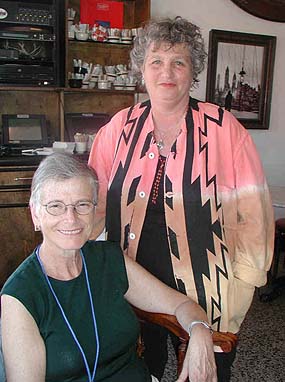My Dear Friends

Joyce Warshow
When news of Joyce Warshow’s death reached me — through an e-mail message, as so much from my old home reaches me now — I felt my whole body go numb and, even more, my heart. Joyce had been struggling with her body for several years. Now I can trace the history of her body’s journey through my memories: that summer weekend, perhaps five years ago, I spent with Joyce and Dorothy at their home in the Hamptons, the three of us floating in their pool — the way some women can do, our feet not touching the bottom, our mouths going as quickly as our below-
I think we were already engaged in the film Joyce had decided to make about me. I can’t remember when I first met Joyce, the exact year — we were part of New York’s lesbian-feminist community for many overlapping years — but I do remember the first formal event to which she invited me. It was to a discussion in an Upper West Side apartment where Joyce had gathered lesbian activists in their middle years to talk about their motivations and dreams. I believe she was video-
But it was working with Joyce on her films — first as a volunteer with the Lesbian Herstory Archives as she collected her materials on Blue Lunden for her first film and then, in the most intense period of our friendship, working with her as she shaped Hand on the Pulse. Joyce sitting with me, asking me hour after hour about my childhood, my mother, my writing, interviewing my friends, focusing the camera and her narrative, introducing me to the wonderful women who, inspired by her dedication, became the camera woman for a day or the film editor or the sound technician, all volunteering their services, some on their way to other parts of the world, in town for just a few days to share their expertise with Joyce, to be part of her project.
She told me that some of her friends were not happy with her choice of me as a subject. “Why do you want to do a film about a pornographer?” she was asked. Joyce and I did have different lesbian histories— and the deepest meaning of the film for me was her attempt to understand the whys of my life — why sex, why Regina, why the Archives, why the sex wars — her acts of generosity in reaching for my life. Hours and hours together and then, when the film was finished, appearing with Joyce from time to time when we were in the same hemisphere, Di and I visiting with Joyce and Dorothy in Fort Lauderdale for the Miami Gay and Lesbian Film Festival, walking along the beach, Joyce already in treatment. I remember explaining my passion for miniature golf to Joyce and, lo and behold, she found us one of the few old-
The last time I was in New York, from mid-December 2006 to May 2007, I visited with Joyce and Dorothy as often as I could. And there was Joyce, once again launched on another film, her last, about the activism of Charlotte Bunch. I saw Joyce grow weak and thin and still push for the next shot. Dorothy arranged a surprise birthday party for Joyce in a swanky downtown restaurant and there we all were: her family and her friends, some friends of long, long standing and others from different decades in her life. When she entered the room, Joyce stood very still, her hand on her heart — all her elegance of stance, her gentle wonder at what Dorothy had managed to do and that she should be the recipient of so much attention, so much love.
I could not write this until I was ready to accept that I would never hear Joyce’s voice, coming over oceans, again, that her words of concern for my health, for my well-being, would never reach me. I am very far away from much I love — Joyce persisted in caring for me, even when I drifted away. How I will listen for your call.
November 1, 2007
More about Joyce
Death Notice at the New York TimesGuest Book at the New York Times (online until October 3, 2008)
“Remembering Joyce Warshow,” by Rabbi Sharon Kleinbaum (Jewish Women’s Archive)
Contributions in honor of Joyce Warshow can be made to: Women Make Movies, 462 Broadway, Suite 500WS, New York, NY 10013.